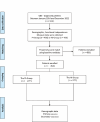A propensity score matched retrospective study of psychological and behavioral therapy impact on muscle function recovery in Guillain Barré Syndrome
- PMID: 40883445
- PMCID: PMC12397223
- DOI: 10.1038/s41598-025-16482-8
A propensity score matched retrospective study of psychological and behavioral therapy impact on muscle function recovery in Guillain Barré Syndrome
Abstract
Guillain-Barré Syndrome (GBS) is an autoimmune disorder that leads to acute flaccid paralysis and often results in long-term sequelae such as muscle weakness and sensory dysfunction. While recovery is possible, current rehabilitation strategies for muscle function and nerve regeneration often show limited effectiveness and require prolonged treatment. Psychological and behavioral therapy has shown promise in enhancing recovery by improving patient compliance and emotional stability. However, its impact on muscle function recovery in GBS patients remains poorly studied. This research aims to explore the role of psychological and behavioral therapy in improving muscle function and neurological recovery in GBS survivors. Patients diagnosed with classic or variant forms of GBS at the General Hospital of the Western Theater Command from January 2014 to January 2022 were included in this study. Based on the treatment measures received, the patients were divided into two groups: the treatment group received psychological and behavioral therapy in addition to conventional neuromuscular rehabilitation, while the control group received only conventional neuromuscular rehabilitation. The primary outcome measure was the Barthel Index for activities of daily living, and secondary measures included disability scores and sensory function scores. PSM was used to balance baseline characteristics between the two groups, and statistical analyses were performed to assess differences in therapeutic efficacy. After 1:1 Propensity Score Matching (PSM), 277 matched pairs were obtained. There were no significant differences in age, hypertension, diabetes, alcohol consumption, disability scores, sensory function scores, or Barthel Index scores between the two groups (P > 0.05). Comparison of functional assessments at discharge and 6 months after discharge. The results indicate that both the PI-Group and the NI-Group had significant recovery in functional scores (P < 0.05). In different subgroups, the results show that the more severe the condition, the higher the degree of benefit after psychobehavioral therapy (P < 0.05). The analysis suggests that the more severe the condition, the larger the SMD difference. Psychological and behavioral therapy significantly enhances daily functional independence and neuromuscular function recovery in patients with GBS sequelae. It can serve as an effective supplement to conventional rehabilitation. This therapy potentially improves patients' adherence to rehabilitation, alleviates anxiety, and motivates active participation in training, thereby accelerating the recovery of daily living and neuromuscular functions. Further studies are needed to explore its mechanisms and long-term efficacy to provide stronger scientific evidence for GBS rehabilitation.
Keywords: Guillain-Barré Syndrome; Neuromuscular rehabilitation; Propensity score matching; Psychological and behavioral therapy.
© 2025. The Author(s).
Conflict of interest statement
Declarations. Competing interests: The authors declare no competing interests.
Figures




Similar articles
-
Prescription of Controlled Substances: Benefits and Risks.2025 Jul 6. In: StatPearls [Internet]. Treasure Island (FL): StatPearls Publishing; 2025 Jan–. 2025 Jul 6. In: StatPearls [Internet]. Treasure Island (FL): StatPearls Publishing; 2025 Jan–. PMID: 30726003 Free Books & Documents.
-
Plasma exchange for Guillain-Barré syndrome.Cochrane Database Syst Rev. 2002;(2):CD001798. doi: 10.1002/14651858.CD001798. Cochrane Database Syst Rev. 2002. Update in: Cochrane Database Syst Rev. 2012 Jul 11;(7):CD001798. doi: 10.1002/14651858.CD001798.pub2. PMID: 12076424 Updated.
-
Intravenous immunoglobulin for Guillain-Barré syndrome.Cochrane Database Syst Rev. 2014 Sep 19;2014(9):CD002063. doi: 10.1002/14651858.CD002063.pub6. Cochrane Database Syst Rev. 2014. PMID: 25238327 Free PMC article.
-
Plasma exchange for Guillain-Barré syndrome.Cochrane Database Syst Rev. 2001;(2):CD001798. doi: 10.1002/14651858.CD001798. Cochrane Database Syst Rev. 2001. Update in: Cochrane Database Syst Rev. 2002;(2):CD001798. doi: 10.1002/14651858.CD001798. PMID: 11406009 Updated.
-
Pharmacological treatment for pain in Guillain-Barré syndrome.Cochrane Database Syst Rev. 2015 Apr 9;2015(4):CD009950. doi: 10.1002/14651858.CD009950.pub3. Cochrane Database Syst Rev. 2015. PMID: 25855461 Free PMC article.
References
-
- Hawkes, M. A. & Wijdicks, E. F. M. Improving outcome in severe myasthenia gravis and Guillain-Barré Syndrome. Semin. Neurol.44, 263–270. 10.1055/s-0044-1785509 (2024). - PubMed
-
- Grelowska, M., Logoń, K. & Dziadkowiak, E. Prognostic factors associated with worse outcomes in patients with GBS: A systematic review. Adv. Clin. Exp. Med.10.17219/acem/186949 (2024). - PubMed
-
- Estublier, B. et al. Long-term outcomes of paediatric Guillain-Barré syndrome. Dev. Med. Child. Neurol.66, 176–186. 10.1111/dmcn.15693 (2024). - PubMed
MeSH terms
LinkOut - more resources
Full Text Sources
Medical
Research Materials
Miscellaneous

